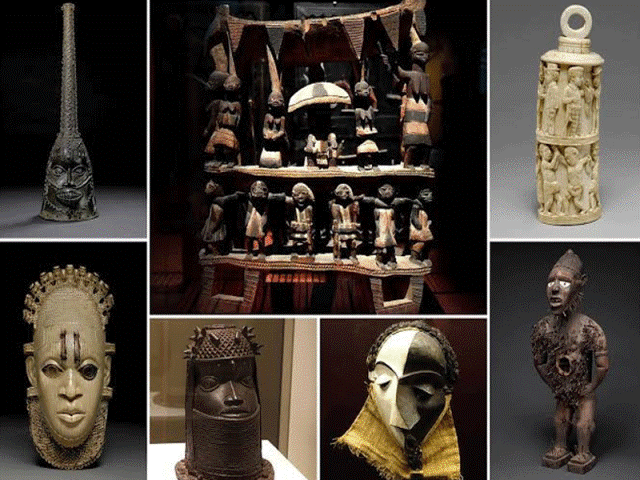…As Germany sets to return 1,130 looted Benin bronzes
The Smithsonian’s National Museum of African Art transferred ownership of 29 Benin bronzes to the National Commission for Museums and Monuments in Nigeria.
The bronzes, which were part of the museum’s collection, were stolen from Nigeria during the 1897 British raid on Benin City.
The Smithsonian’s Board of Regents voted to de-accession the bronzes in June in keeping with the Smithsonian’s new ethical returns policy.
The transfer of ownership was formalized in a ceremony at the National Museum of African Art Tuesday, Oct. 11. The ceremony was held in conjunction with the National Gallery of Art, which returned the Benin bronze from its collection.
“Not only was returning ownership of these magnificent artifacts to their rightful home the right thing to do, it also demonstrates how we all benefit from cultural institutions making ethical choices,” said Lonnie Bunch, Secretary of the Smithsonian.
“Sharing knowledge and stewardship with origin communities will help us better understand and preserve important cultural heritage like the Benin bronzes and illuminate it for future generations in the United States and around the world.”
The Secretary was joined at the ceremony by Ngaire Blankenberg, director of the National Museum of African Art; Kaywin Feldman, director of the National Gallery of Art; Lai Mohammed, Minister of Information and Culture of Nigeria; and Prince Aghatise Erediauwa, representing the Oba, or the traditional ruler of the Kingdom of Benin.
“Nigeria is immensely gratified at the commendable decision of the Smithsonian’s National Museum of African Art, the National Gallery of Art and the Rhode Island School of Design to return these artefacts that left Africa over a century ago,” Mohammed said. “Nigeria looks forward to working with these institutions on joint exhibitions and other educational exchanges. By returning the artefacts, these institutions are together writing new pages in history. Their brave decision to return the timeless artworks are worth emulating.”
The return of these Benin Bronzes is the first return under the Smithsonian’s new ethical returns policy announced this spring. This policy authorizes Smithsonian museums to return collections to the community of origin based on ethical considerations, such as the manner and circumstances in which the items were originally acquired.
In addition to the National Museum of African Art’s collection, the Smithsonian’s National Museum of Natural History has a collection of 20 Benin bronzes. Provenance research for that collection has been undertaken and will be submitted to the Board of Regents as a request to deaccession bronzes obtained during the 1897 expedition and return them to Nigeria.
The Kingdom of Benin, home of the Edo peoples, is located in the southwest tropical forest and mangroves region of present-day Nigeria. The Kingdom of Benin is renowned for the exceptional quality and diversity of its royal arts fashioned in copper alloy, ivory, terracotta, wood, iron and coral beads.
In 1897 during a British raid on Benin, the royal palace was burned and looted, and the oba (ruler) was exiled.
The British confiscated all royal treasures, giving some to individual officers and taking most to auction in London.
The estimated 3,000 objects eventually made their way into museums and private collections around the world.
The collection of the National Museum of African Art includes 39 artworks from Nigeria attributed as Benin Kingdom court style. The majority of these artworks are dated, based on style, from the late 15th or early 16th century through the late 19th century.
A 2021 provenance evaluation of the collection determined that 29 artworks were removed during the 1987 raid. There are six additional bronzes that require more research to understand their origin.
The Benin bronzes entered the museum’s collection through purchase, transfer, donation and bequest. Twenty pieces were transferred from the Smithsonian’s Hirshhorn Museum and Sculpture Garden. The donor, Joseph H. Hirshhorn, had acquired the works through private dealers and auctions.
Meanwhile, the minister of information and culture, Mr. Lai Mohammed said that Nigeria had signed an agreement with Germany for the repatriation of over 1,130 looted Benin Bronze artifacts to the country.
Mohammed disclosed this in Washington DC yesterday after three museums in the U.S. repatriated 31 Benin Bronze artifacts to Nigeria.
He commended the German government for that effort, adding that Nigeria is also getting positive responses from France and Mexico to return some of its stolen artifacts.
In 1897 during a British raid on Benin, the royal palace was torched and looted, and the oba (ruler) was exiled.
The British confiscated all royal treasures, giving some to individual officers and taking most to auction in London.
The estimated 3,000 objects eventually made their way into museums and private collections around the world.
The minister said the world had seen that it was an ethical and moral issue to return the artifacts back to their owners, noting that it is not a matter of law as claimed by the British Government.
“This is important for the British Museum to understand and for the British Government to know because I was also in the British Museum to ask them to return thousands of the artifacts in its custody.
“The standard response is that until the British Parliament changes the status, they are not in a position to so do.
“The U.S. and Germany are now seeing that this matter is not of law but of morality, is about doing the right thing. I hope that the British government will also learn from the two countries and so same,’’ he said.
According to him, Nigeria is planning to sign an agreement with the British Government on November 28 to return about 86 other artefacts from various museums in UK.
The minister said the campaign of the current administration for the return of and restitution of Nigeria’s looted /smuggled artifacts from around the world, which was launched in November 2019, was yielding positive result.
He said in January, Nigeria and the U.S. signed the bilateral cultural property agreement to prevent illicit import into the U.S. of some categories of Nigerian artifacts.
“This agreement solidifies our shared commitment to combat looting and trafficking of the precious cultural property while also establishing a process for the return of trafficked cultural objects, thus reducing the incentives to loot sites in Nigeria.”
Mohammed said reclaiming the looted artifacts was important to enhance the cultural values of those artworks, adding that Nigeria would continue to intensify its campaign for their repatriation.
The minister said that the circumstance in which they were removed from Nigeria was punitive and there’s been a new wave, a new trend all by the world that stolen artifacts should be returned to their owners.
“Because for many art lovers, they don’t see beyond the aesthetic of these artifacts; these artifacts are also intrinsic and integral parts of our history.
“Our culture is followed by social life, so it’s only fair to return them. It is moral to do so, it would enhance and improve the youth’s understanding of their cultural background and history.
“Some of these cultural artifacts looted are used for certain ceremonies such as the coronation of a new Oba (king). Sometimes they are used as calendars to mark events in the community,’’ he said.
In addition, the minister said that the Nigerian government was working on an arrangement to embark on travelling exhibitions of the returned artifacts.
“We are starting it very soon, and in conjunction with stakeholders, the National Commission for Museums and Monuments of Nigeria will embark on international travelling exhibitions.
“We want to embark on International travelling exhibitions with the artifacts being repatriated in a manner that will win more friends and promote greater goodwill and ethnic groups that produced the artifacts,’’ he said.
With ThisDay, NAN reports

























































